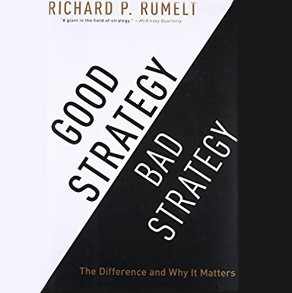Good Strategy Bad Strategy: the Difference and Why It Matters
About This Book:
Clears out the mumbo jumbo and muddled thinking underlying too many strategies and provides a clear way to create and implement a powerful action-oriented strategy for the real world
Developing and implementing a strategy is the central task of a leader, whether the CEO at a Fortune 100 company, an entrepreneur, a church pastor, the head of a school, or a government official. Richard Rumelt shows that there has been a growing and unfortunate tendency to equate Mom-and-apple-pie values, fluffy packages of buzzwords, motivational slogans, and financial goals with “strategy.” He debunks these elements of “bad strategy” and awakens an understanding of the power of a “good strategy.”
A good strategy is a specific and coherent response to—and approach for overcoming—the obstacles to progress. A good strategy works by harnessing and applying power where it will have the greatest effect in challenges as varied as putting a man on the moon, fighting a war, launching a new product, responding to changing market dynamics, starting a charter school, or setting up a government program. Rumelt’s
nine sources of power—ranging from using leverage to effectively focusing on growth—are eye-opening yet pragmatic tools that can be put to work on Monday morning.
Surprisingly, a good strategy is often unexpected because most organizations don’t have one. Instead, they have “visions,” mistake financial goals for strategy,
and pursue a “dog’s dinner” of conflicting policies and actions.
Rumelt argues that the heart of a good strategy is insight—into the true nature of the situation, into the hidden power in a situation, and into an appropriate response. He shows you how insight can be cultivated with a wide variety of tools for guiding your
own thinking.
Good Strategy/Bad Strategy uses fascinating examples from business, nonprofit, and military affairs to bring its original and pragmatic ideas to life. The detailed examples range from Apple to General Motors, from the two Iraq wars to Afghanistan, from a small local market to Wal-Mart, from Nvidia to Silicon Graphics, from the Getty Trust to the Los Angeles Unified School District, from Cisco Systems to Paccar, and from Global Crossing to the 2007–08 financial crisis.
Reflecting an astonishing grasp and integration of economics, finance, technology, history, and the brilliance and foibles of the human character, Good Strategy/Bad Strategy stems from Rumelt’s decades of digging beyond the superficial to address hard questions with honesty and integrity.
About the Author:
Rumelt’s research has centered on corporate diversification strategy and the sources of sustainable advantage to individual business strategies. His current research interests center on the dynamics of industry transitions with a focus on the patterns and forces shaping the evolution of complex industries.
Rumelt received his doctorate from the Harvard Business School in 1972. He joined the UCLA faculty in 1976. He was President of the Strategic Management Society in 1995-98. He received the Irwin Prize for his book Strategy, Structure, and Economic Performance. In 1997, he was appointed Telecom Italia Strategy Fellow, a position he held until April 2000. He has won teaching awards at UCLA and received a “best paper prize” in 1997 from the Strategic Management Journal.
Information pulled from Goodreads.
External Summaries
Review of Good Strategy, Bad Strategy by Washington Times
Review of Good Strategy, Bad Strategy by INC
Review of Good Strategy, Bad Strategy by Marc Abraham
Buy Good Strategy Bad Strategy on Amazon
Summary of Good Strategy, Bad Strategy by Blinkist Freemium
Summary of Good Strategy, Bad Strategy by Get Abstract Freemium
Summary of Good Strategy, Bad Strategy by Actionable Books Free
Summary of Good Strategy, Bad Strategy by Good Bad Strategy Free
